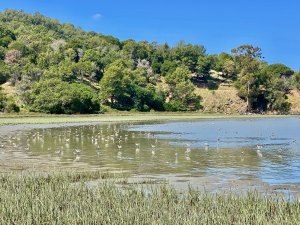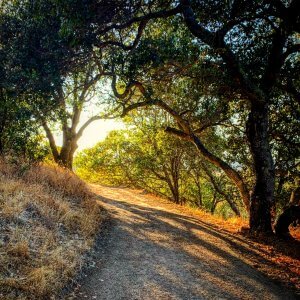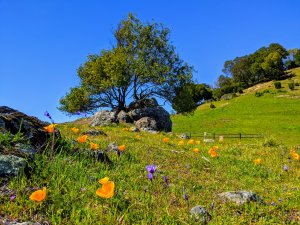
Ecosystems
Learn about China Camp’s three main ecosystems
SALT MARSHES | OAK WOODLANDS | GRASSLANDS
Salt marshes
 The tidal wetlands ringing the shoreline of China Camp State Park are some of the healthiest of their kind in the San Francisco Bay Estuary. Once common throughout the region, salt marshes have been decimated by development, making the park’s vibrant tidal wetlands environmentally significant, ecologically valuable, and important to protect.
The tidal wetlands ringing the shoreline of China Camp State Park are some of the healthiest of their kind in the San Francisco Bay Estuary. Once common throughout the region, salt marshes have been decimated by development, making the park’s vibrant tidal wetlands environmentally significant, ecologically valuable, and important to protect.
The benefits of salt marshes abound. Researchers have discovered that, as water flows from the mouth of the Sacramento Delta towards the the ocean through the Golden Gate, China Camp’s wetlands act as a massive natural filter. These tidal wetlands also reduce runoff and erosion, and provide protected “nurseries” for fish.
What’s more, salt marshes serve an essential role in trapping excess carbon deep within the mudflats, a critical step toward mitigating the causes of climate change. Global warming and its impacts pose numerous threats to salt marshes, including accelerated sea-level rise, erratic precipitation, erosion, and more frequent and intense storms.
Safe haven for endangered species
China Camp’s salt marshes provide protected habitat for wildlife, including two endangered species: the salt marsh harvest mouse (Reithrodontomys raviventris), listed on both federal and state endangered species lists, and Ridgway’s rail (Rallus longirostris obsoletus), a nearly flightless shorebird.
China Camp State Park is part of the San Francisco Bay National Estuarine Research Reserve. Check out the organization’s extensive website for information on wetland ecosystems and water quality. Also find details about educational programs for science teachers and local school groups.
Oak woodlands
 Of the 25 species of oak that are native to California, four of them grown in China Camp State Park. Most prevalent are deciduous valley oak (Quercus lobateata), with elegant specimens soaring above the grasses at Back Ranch and Miwok Meadows, and the evergreen coast live oak (Quercus agrifolia), whose gnarled trunk and branches form an iconic presence on our hillsides. Walk Turtle Back Hill Nature Trail (pictured here) to see two more deciduous species, black oak (Quercus kelloggii) and blue oak (Quercus douglasii). For more on these beautiful trees, visit California Oaks.
Of the 25 species of oak that are native to California, four of them grown in China Camp State Park. Most prevalent are deciduous valley oak (Quercus lobateata), with elegant specimens soaring above the grasses at Back Ranch and Miwok Meadows, and the evergreen coast live oak (Quercus agrifolia), whose gnarled trunk and branches form an iconic presence on our hillsides. Walk Turtle Back Hill Nature Trail (pictured here) to see two more deciduous species, black oak (Quercus kelloggii) and blue oak (Quercus douglasii). For more on these beautiful trees, visit California Oaks.
Of course, oaks aren’t our only trees. California bay laurel (shown here) thrives here; look for twining, multi-trunked trees with glossy, aromatic leaves and crowns of flowers in spring. Other shrubs and trees include big-leaf maple, toyon, madrone, and manzanita. Also look for umbrella-like California buckeye (Aesculus californica),found alongside streams throughout the park. In the fall, it’s one of the first plants to lose its leaves and dropping “horse chestnuts” on our trails. (Beware: these faux chestnuts, the largest seeds of any tree outside the tropics, are poisonous.) Along Bay View Trail, slip into hushed coast redwood groves in the deep canyons of San Pedro Mountain.
Grasslands & meadows
 Though severely impacted by cattle and other human impacts over the centuries, the grasslands of China Camp State Park now have the potential to return to their native state. In the late 1700s, Spanish ranchers introduced nonnative annual grasses to provide feed for cattle. These exotic species quickly overtook the region’s native grasses.
Though severely impacted by cattle and other human impacts over the centuries, the grasslands of China Camp State Park now have the potential to return to their native state. In the late 1700s, Spanish ranchers introduced nonnative annual grasses to provide feed for cattle. These exotic species quickly overtook the region’s native grasses.
Today, with ranchers gone and the land protected, native grasses are once again thriving in China Camp’s meadows. Look for purple needlegrass (Nassella pulchra), the official state grass of California. This hardy annual thrives in China Camp’s serpentine-rich soils. The grass’s seeds were a staple of the diet of the local Coast Miwok. Find more information at California Native Grasslands Association.

